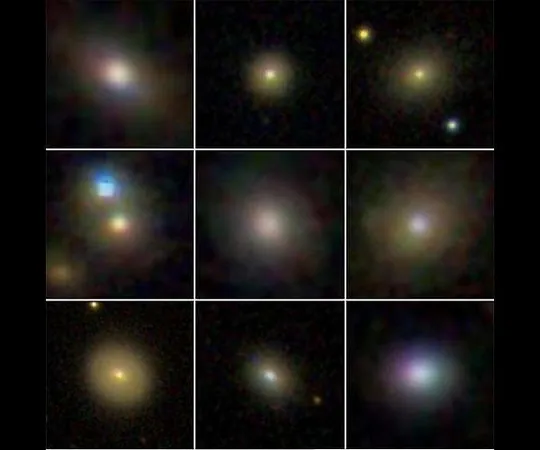
Unveiling the Mysteries of the Early Universe: Discoveries of Ultra-Faint Dwarf Galaxies
2025-01-17
Author: Siti
Introduction
In a groundbreaking discovery, astronomers have revealed the existence of three ultra-faint dwarf galaxies—Sculptor A, B, and C—situated near NGC 300, which is approximately 6.5 million light-years away from Earth. This significant finding was led by David Sand, a professor of astronomy at the University of Arizona's Steward Observatory, and presents a unique opportunity to glean insights into the formation and evolution of the smallest galaxies in our universe.
Discovery Unveiled
The findings were unveiled during a press conference at the 245th Meeting of the American Astronomical Society, where Sand explained the implications of these discoveries, now published in *The Astrophysical Journal Letters*. Ultra-faint dwarf galaxies, which contain only a few hundred to thousands of stars—compared to billions in larger galaxies—are notoriously elusive. Their faintness makes them challenging to detect, often requiring proximity to larger galaxies for astronomers to locate them. However, this can complicate our understanding of these galaxies because the gravitational influence of larger neighbors, like the Milky Way, can strip away their gas and hamper their natural evolution.
Significance of the Discovery
Sand emphasized the significance of this discovery: “Small galaxies like these are remnants from the early universe. They help us understand what conditions were like when the first stars and galaxies formed, as well as why some galaxies ceased to form new stars entirely.”
The Search for Sculptor Galaxies
The discovery of the Sculptor galaxies was not an easy feat. Sand recounts his experience during the pandemic when he took on a manual search of the sky through the DECam Legacy Survey (DECaLS) images. After several hours of scanning areas that had yet to be explored, he serendipitously identified these faint structures.
Unique Location for Study
The unique location of the Sculptor galaxies—far from the gravitational influence of larger cosmic entities—offers a pristine environment for study. To further investigate these newly found galaxies, the research team utilized the Gemini South telescope, part of the International Gemini Observatory. High-resolution imaging captured by the Gemini Multi-Object Spectrograph revealed that the Sculptor galaxies are almost devoid of gas and exist primarily as old stellar populations, highlighting that their star formation likely ceased billions of years ago.
Understanding Gas Depletion
Sand noted, “Gas is crucial for creating new stars, but ultra-faint dwarf galaxies lack sufficient gravity to retain this material, which can easily dissipate when large galaxies are nearby.” The findings suggest two possible scenarios that might explain the gases’ absence: the Epoch of Reionization, a period shortly after the Big Bang when intense ultraviolet radiation may have stripped gas from these small galaxies, or explosive supernovae from ancient stars that propelled gas away from the galaxies at incredible speeds.
Bridging the Gap
By studying dwarf galaxies like Sculptor A, B, and C, astronomers hope to bridge the gap between the current structure of galaxies and their formation in the very early cosmos. “Understanding the nature of reionization and its effects on our universe is essential. We still don’t know how uniform or intense it was,” Sand explained.
Future Plans
To further explore the cosmic past, Sand and his team plan to employ advanced machine learning techniques to identify more such faint dwarf galaxies. With these tools, they aim to accelerate the discovery process, enabling researchers to draw deeper conclusions about the early universe and its evolution.
Conclusion
As science continues to peel away the layers of the cosmos, the implications of finding such elusive galaxies could reshape our understanding of the universe and its origins. Stay tuned as we delve deeper into the mysteries of our cosmic neighborhood!


 Brasil (PT)
Brasil (PT)
 Canada (EN)
Canada (EN)
 Chile (ES)
Chile (ES)
 Česko (CS)
Česko (CS)
 대한민국 (KO)
대한민국 (KO)
 España (ES)
España (ES)
 France (FR)
France (FR)
 Hong Kong (EN)
Hong Kong (EN)
 Italia (IT)
Italia (IT)
 日本 (JA)
日本 (JA)
 Magyarország (HU)
Magyarország (HU)
 Norge (NO)
Norge (NO)
 Polska (PL)
Polska (PL)
 Schweiz (DE)
Schweiz (DE)
 Singapore (EN)
Singapore (EN)
 Sverige (SV)
Sverige (SV)
 Suomi (FI)
Suomi (FI)
 Türkiye (TR)
Türkiye (TR)
 الإمارات العربية المتحدة (AR)
الإمارات العربية المتحدة (AR)